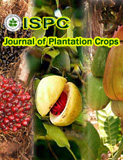Phytosterol Composition in the Oil of Bi-clonal Seed Stocks of Tea (Camellia sinensis L.) in North East India
Phytosterol in tea seed oil
DOI:
https://doi.org/10.25081/jpc.2023.v51.i3.8339Abstract
The phytosterols are naturally occurring, physiologically active substances found in foods of plant origin. In present study, the phytosterols profile of four bi-clonal tea seed stock oils viz., TS 462, TS 464, TS 491, and TS 506 released from Tocklai are presented. Phytosterols were evaluated using GC-FID. Among the phytosterols, 24-methylene cycloartan-3-ol was recorded as the most abundant sterol in tea seed oil, accounting for 31% of total phytosterols. Results showed that the majority of the sterol differences were significant (p 0.05). TS 506 has the highest 24- methylene cycloartan-3-ol (476.03.7 mg kg-1) followed by TS 491 (475.97 mg kg-1). β-sitosterol, cycloartenol, canophyllol, lanosterol and campesterol were also present with their contents of 371.03 ± 0.26, 291.38 ± 0.12, 120.44 ± 0.13, 89.12 ± 0.19 and 69.05 ± 0.24 mg kg-1 respectively. The outcomes of the present study provided a foundational understanding of the phytosterols profiles of the four bi-clonal tea seed oils and highlighted their similarities and differences.
Downloads
References
Álvarez-Sala, A. et al. 2018. Physiological concentrations of phytosterols enhance the apoptotic effects of 5-fluorouracil in colon cancer cells. J. Funct. Foods 49, 52–60.
AOAC,1996. International Official Method 994.10: Cholesterol in Foods-Direct Saponification-Gas Chromatographic Methods, Association of Official Analytical Chemists, Arlington, VA, USA.
Azadmard-Damirchi, S. and Dutta, P.C. 2006. Novel solid-phase extraction method to separate 4-desmethyl-, 4-monomethyl-, and 4,4′-dimethylsterols in vegetable oils. J. Chrom. A. 1108, 183–187.
Bai, G., Ma, C. and Chen, X. 2021. Phytosterols in edible oil: Distribution, analysis and variation during processing. Grain Oil Sci. Tech. 4, 33–44.
Demirag, O. and Konuskan, D.B. 2021. Quality Properties, Fatty Acid and Sterol Compositions of East Mediterranean Region Olive Oils. J. Oleo Sci. 70(1):51–58. doi:10.5650/jos.ess20179
Han, J.H., Yang, Y.X. and Feng, M.Y. 2008. Contents of Phytosterols in Vegetables and Fruits Commonly consumed in China. Biomed. Envir. Sci. 21,449–453.
Lanzani, C. et al. 2016. Lanosterol Synthase Gene Polymorphisms and Changes in Endogenous Ouabain in the Response to Low Sodium Intake. Hypertension. 67, 342–348.
Lee, C.P. and Yen, G.C. 2006. Antioxidant Activity and Bioactive Compounds of Tea Seed (Camellia oleiferaAbel.) Oil. J. Agri. Food Chem. 54, 779–784.
Li, G. et al. 2022. Extraction of Oils and Phytochemicals from Camellia oleifera Seeds: Trends, Challenges, and Innovations. Processes 10, 1489.
Lim, L. et al. 2011. Lanosterol induces mitochondrial uncoupling and protects dopaminergic neurons from cell death in a model for Parkinson’s disease. Cell Death and Differentiation. 19, 416–427.
López-García, G. et al. 2019a. Anti-Inflammatory and Cytoprotective Effect of Plant Sterol and Galactooligosaccharides-Enriched Beverages in Caco-2 Cells. J. Agri. Food Chem. 68, 1862–1870.
Lopez Garcia, G. et al. 2019b. Effect of a Milk-Based Fruit Beverage Enriched with Plant Sterols and/or Galactooligosaccharides in a Murine Chronic Colitis Model. Foods. 8, 114.
Moghadasian, M.H. 2000. Pharmacological properties of plant sterols in vivo and in vitro observations. Life Sciences. 67, 605–615.
Patel, P.K. et al. 2020. Tea seed oil: Physicochemical profiling. J. Plant . Crops, 48 (3) 247–251. doi: 10.25081/jpc.2020.v48.i3.6633.
Plat, J. et al. 2019. Plant-based sterols and Stanols in health disease: “Consequences of human development in a plant-based environment?” Progress Lipid Res.74, 87–102.
Salehi, B. et al. 2021. Phytosterols: From Preclinical Evidence to Potential Clinical Applications. Front. Pharm. 11.
Sarmah, K. et al. 2018. Biochemical characterization of tea (Camellia spp.) seed oil cake. B. Envir. Pharm. Life Sci. 7, 98–102.
USDA, 1999. Nutrient Database, Release 12, US Department of Agriculture, Washington, DC.
Van, Rensburg, S.J. et al. 2000. A comparative study of the effects of cholesterol, beta-sitosterol, beta-sitosterol glucoside, dehydroepiandrosterone sulphate and melatonin on in vitro lipid peroxidation. Metabolic Brain Disease 15, 257–265.
Witkowska, A.M. et al. 2021. Assessment of Plant Sterols in the Diet of Adult Polish Population with the Use of a Newly Developed Database. Nutrients 13, 2722.
Yang, R. et al. 2019. Phytosterol Contents of Edible Oils and Their Contributions to Estimated Phytosterol Intake in the Chinese Diet. Foods 8, 334.
Zakłos-Szyda, M. 2015. Phytosterols in type 2 diabetes and obesity – molecular mechanisms of action. Research Signpost.
Zhang, H. et al. 2017. Rapid recovery of high content phytosterols from corn silk. Chem. Central J. 11.
Published
How to Cite
Issue
Section
Copyright (c) 2024 Journal of Plantation Crops

This work is licensed under a Creative Commons Attribution 4.0 International License.







 .
.